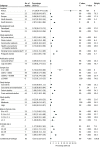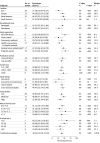Global Percentage of Asymptomatic SARS-CoV-2 Infections Among the Tested Population and Individuals With Confirmed COVID-19 Diagnosis: A Systematic Review and Meta-analysis
- PMID: 34905008
- PMCID: PMC8672238
- DOI: 10.1001/jamanetworkopen.2021.37257
Global Percentage of Asymptomatic SARS-CoV-2 Infections Among the Tested Population and Individuals With Confirmed COVID-19 Diagnosis: A Systematic Review and Meta-analysis
Abstract
Importance: Asymptomatic infections are potential sources of transmission for COVID-19.
Objective: To evaluate the percentage of asymptomatic infections among individuals undergoing testing (tested population) and those with confirmed COVID-19 (confirmed population).
Data sources: PubMed, EMBASE, and ScienceDirect were searched on February 4, 2021.
Study selection: Cross-sectional studies, cohort studies, case series studies, and case series on transmission reporting the number of asymptomatic infections among the tested and confirmed COVID-19 populations that were published in Chinese or English were included.
Data extraction and synthesis: This meta-analysis was conducted following the Preferred Reporting Items for Systematic Reviews and Meta-Analyses (PRISMA) guideline. Random-effects models were used to estimate the pooled percentage and its 95% CI. Three researchers performed the data extraction independently.
Main outcomes and measures: The percentage of asymptomatic infections among the tested and confirmed populations.
Results: Ninety-five unique eligible studies were included, covering 29 776 306 individuals undergoing testing. The pooled percentage of asymptomatic infections among the tested population was 0.25% (95% CI, 0.23%-0.27%), which was higher in nursing home residents or staff (4.52% [95% CI, 4.15%-4.89%]), air or cruise travelers (2.02% [95% CI, 1.66%-2.38%]), and pregnant women (2.34% [95% CI, 1.89%-2.78%]). The pooled percentage of asymptomatic infections among the confirmed population was 40.50% (95% CI, 33.50%-47.50%), which was higher in pregnant women (54.11% [95% CI, 39.16%-69.05%]), air or cruise travelers (52.91% [95% CI, 36.08%-69.73%]), and nursing home residents or staff (47.53% [95% CI, 36.36%-58.70%]).
Conclusions and relevance: In this meta-analysis of the percentage of asymptomatic SARS-CoV-2 infections among populations tested for and with confirmed COVID-19, the pooled percentage of asymptomatic infections was 0.25% among the tested population and 40.50% among the confirmed population. The high percentage of asymptomatic infections highlights the potential transmission risk of asymptomatic infections in communities.
Conflict of interest statement
Figures




References
-
- World Health Organization. WHO coronavirus disease (COVID-19) dashboard. Accessed January 28, 2021. https://covid19.who.int/
-
- World Health Organization. Coronavirus disease (COVID-19): how is it transmitted? December 13, 2020. Accessed January 22, 2021. https://www.who.int/news-room/q-a-detail/coronavirus-disease-covid-19-ho...
Publication types
MeSH terms
LinkOut - more resources
Full Text Sources
Medical
Miscellaneous

